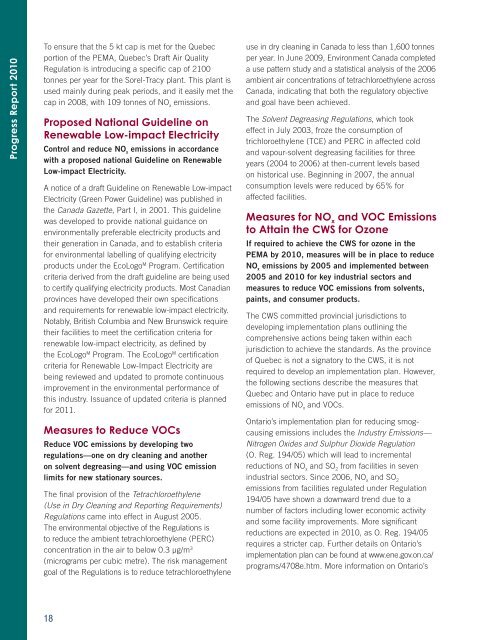2010 Progress Report - International Joint Commission
2010 Progress Report - International Joint Commission
2010 Progress Report - International Joint Commission
Create successful ePaper yourself
Turn your PDF publications into a flip-book with our unique Google optimized e-Paper software.
<strong>Progress</strong> <strong>Report</strong> <strong>2010</strong><br />
To ensure that the 5 kt cap is met for the Quebec<br />
portion of the PEMA, Quebec’s Draft Air Quality<br />
Regulation is introducing a specifi c cap of 2100<br />
tonnes per year for the Sorel-Tracy plant. This plant is<br />
used mainly during peak periods, and it easily met the<br />
cap in 2008, with 109 tonnes of NO x<br />
emissions.<br />
Proposed National Guideline on<br />
Renewable Low-impact Electricity<br />
Control and reduce NO x<br />
emissions in accordance<br />
with a proposed national Guideline on Renewable<br />
Low-impact Electricity.<br />
A notice of a draft Guideline on Renewable Low-impact<br />
Electricity (Green Power Guideline) was published in<br />
the Canada Gazette, Part I, in 2001. This guideline<br />
was developed to provide national guidance on<br />
environmentally preferable electricity products and<br />
their generation in Canada, and to establish criteria<br />
for environmental labelling of qualifying electricity<br />
products under the EcoLogo M Program. Certifi cation<br />
criteria derived from the draft guideline are being used<br />
to certify qualifying electricity products. Most Canadian<br />
provinces have developed their own specifi cations<br />
and requirements for renewable low-impact electricity.<br />
Notably, British Columbia and New Brunswick require<br />
their facilities to meet the certifi cation criteria for<br />
renewable low-impact electricity, as defi ned by<br />
the EcoLogo M Program. The EcoLogo M certifi cation<br />
criteria for Renewable Low-Impact Electricity are<br />
being reviewed and updated to promote continuous<br />
improvement in the environmental performance of<br />
this industry. Issuance of updated criteria is planned<br />
for 2011.<br />
Measures to Reduce VOCs<br />
Reduce VOC emissions by developing two<br />
regulations—one on dry cleaning and another<br />
on solvent degreasing—and using VOC emission<br />
limits for new stationary sources.<br />
The fi nal provision of the Tetrachloroethylene<br />
(Use in Dry Cleaning and <strong>Report</strong>ing Requirements)<br />
Regulations came into effect in August 2005.<br />
The environmental objective of the Regulations is<br />
to reduce the ambient tetrachloroethylene (PERC)<br />
concentration in the air to below 0.3 μg/m 3<br />
(micrograms per cubic metre). The risk management<br />
goal of the Regulations is to reduce tetrachloroethylene<br />
use in dry cleaning in Canada to less than 1,600 tonnes<br />
per year. In June 2009, Environment Canada completed<br />
a use pattern study and a statistical analysis of the 2006<br />
ambient air concentrations of tetrachloroethylene across<br />
Canada, indicating that both the regulatory objective<br />
and goal have been achieved.<br />
The Solvent Degreasing Regulations, which took<br />
effect in July 2003, froze the consumption of<br />
trichloroethylene (TCE) and PERC in affected cold<br />
and vapour-solvent degreasing facilities for three<br />
years (2004 to 2006) at then-current levels based<br />
on historical use. Beginning in 2007, the annual<br />
consumption levels were reduced by 65% for<br />
affected facilities.<br />
Measures for NO x<br />
and VOC Emissions<br />
to Attain the CWS for Ozone<br />
If required to achieve the CWS for ozone in the<br />
PEMA by <strong>2010</strong>, measures will be in place to reduce<br />
NO x<br />
emissions by 2005 and implemented between<br />
2005 and <strong>2010</strong> for key industrial sectors and<br />
measures to reduce VOC emissions from solvents,<br />
paints, and consumer products.<br />
The CWS committed provincial jurisdictions to<br />
developing implementation plans outlining the<br />
comprehensive actions being taken within each<br />
jurisdiction to achieve the standards. As the province<br />
of Quebec is not a signatory to the CWS, it is not<br />
required to develop an implementation plan. However,<br />
the following sections describe the measures that<br />
Quebec and Ontario have put in place to reduce<br />
emissions of NO x<br />
and VOCs.<br />
Ontario’s implementation plan for reducing smogcausing<br />
emissions includes the Industry Emissions—<br />
Nitrogen Oxides and Sulphur Dioxide Regulation<br />
(O. Reg. 194/05) which will lead to incremental<br />
reductions of NO x<br />
and SO 2<br />
from facilities in seven<br />
industrial sectors. Since 2006, NO x<br />
and SO 2<br />
emissions from facilities regulated under Regulation<br />
194/05 have shown a downward trend due to a<br />
number of factors including lower economic activity<br />
and some facility improvements. More signifi cant<br />
reductions are expected in <strong>2010</strong>, as O. Reg. 194/05<br />
requires a stricter cap. Further details on Ontario’s<br />
implementation plan can be found at www.ene.gov.on.ca/<br />
programs/4708e.htm. More information on Ontario’s<br />
18
















